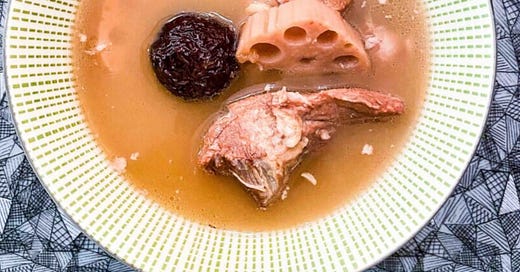Long before bone broth soup became a thing, our Chinese great grandmothers and grandmothers already knew the benefits of feeding their families with good soups. I grew up drinking soups every day, thanks to my late grandma. All I needed was Chinese soup for dinner and I would often dunk all my rice and other dishes into a large bowl of soup and slurp it all up. There is nothing more comforting than a large bowl of soup, it is almost like a hug at the end of a long day.
These days, sadly, not many would bother to boil Chinese soups daily for their families, citing the lack of time or perhaps, just too daunting a task, as it is much easier to pack and go, either from Soup Spoon or pick off a packet of ready-made soups from your local grocers. Nothing cuts it for me like Chinese soups though and I often resort to making my own over the weekends at home.
How to cook your Chinese soups:
There are many ways to do this – you can either use a double boiler, a slow cooker, a pressure cooker or the good old fashioned way, in a pot over the fire. I like cooking over the fire as I find this yields the best flavour. Of course, if you are able to cook it over charcoal fire, that would be even better but most of us won’t have that option these days in our apartments.
What to put into your Chinese soup:
A Cantonese taught me this: your soup is what you put in, it is all about the ingredients, the more generous you are with them, the sweeter your soup will taste. Having said that, don’t go overboard. One can’t have too much of a good thing or one ingredient will overpower the rest.
Meat – You can use pork, poultry (chicken/ duck) or beef, depending on what soups you intend to make. I often use pork and I like to get my supplies from a butcher in Tiong Bahru Market. Pork uncle (as I call him) would ask me if I am going to eat the meat after boiling the soup and he would give me the right cut. Ideally, you want some bones and meat in it. For those who don’t eat the meat, get soup bones. For me, he gives me ribs with decent amount of meat and some bones on it.
Vegetables – Depending on the weather and what you’d like in your soups, there are so many possibilities and you can get a wealth of knowledge on the benefits of each type of soup from the web. Bittergourd soup for hot days to cool down the body, lotus root and pearl beans soup to improve blood circulation, old cucumber soup for anti-ageing and so on and so forth. I just boil what I feel like having for the day and what I can source from my local wet markets.
Dried seafood – There is a huge range of dried seafood which you can add into your soup to flavour it, scallops, dried clams, dried shellfish, dried oysters, dried squid and so on and so forth. I like using dried clams, dried squid, dried scallops and dried edges of the abalone (you can ask your local dried goods shop on what they have).
Dates – I love dates and would often use the organic (sulphur-free ones), both red and black. Blue dates are also available, but tend to be more expensive.
Lotus Root Soup
By @blueskiescottonclouds
This is one of my favourite soups and we would have it weekly growing up. Grandma would add pearl beans into hers and she calls them smart beans, tricking us into eating them on the pretext it would make us smarter.
Serves 4-5
750g of pork, preferably pork ribs
1 large lotus root, peeled and sliced into thick coins
1 large arrowroot, peeled and chopped into manageable chunks
1 bag or a large handful of shelled pearl beans (borlotti beans) or peanuts
2 pieces of dried squid, soaked and plastic-like backbone removed
6-8 red dates depending on how sweet you want your soup to be
1 large black date
Bring a large pot of water to the boil. Blanch your pork in the boiling water for 3-5 minutes to remove all impurities. Remove from the pot and set aside – discard the water. If your pork is fatty, trim the fat after blanching.
Bring a fresh pot of water to the boil and add in all the ingredients. The water should just be 1-2 inches above all the ingredients. Let the soup boil over high heat for 15 minutes, before lowering the heat to a simmer for 2-3 hours.
If you find that your soup is drying up, add in more boiling water. I would often simmer my soups in the morning. An hour before dinner, I would reheat the whole pot of soup at high fire until it reaches the consistency and flavour that I like. The high fire, simmer and high fire at the end technique works for me as I find that the fire extracts all the essence of the ingredients and I am rewarded with a collagen like thick soup. I never season my soup as the ingredients alone add enough salt and flavour but you can add a little bit of salt, if you’d like. Enjoy!




